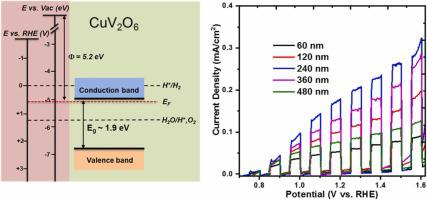Journal of Environmental Chemical Engineering ( IF 7.4 ) Pub Date : 2023-04-10 , DOI: 10.1016/j.jece.2023.109892 Angang Song , Suxiang Liu , Qinpu Wang , Daowei Gao , Junhua Hu

|
This study is an initial account of solution-based spray pyrolysis-produced n-type copper vanadate (CuV2O6) thin film photoanodes. CuV2O6 photoelectrodes have been tested for their ability to oxidize water in aqueous (pH 6.8) solutions using photoelectrochemical (PEC) tests. The band edge positions, band gap energy, photocurrent generation, flat band potential, chemical make-up, chemical stability, charge carrier transit, and O2 production faradic efficiency are a few of the physical and photophysical features measured and described. According to the findings, CuV2O6 possesses a satisfactory bandgap of 1.9 eV and appropriate band locations that allow for the use of visible light for overall solar water splitting. Under AM1.5 simulated sunlight, the maximum photocurrent density recorded is 0.18 mA cm− 2 at 1.23 VRHE with Na2SO3 acting as a hole scavenger. As evidenced by film shape, surface compositions before and after the PEC measurements, and outstanding structural and compositional stability throughout the oxygen evolution reaction (OER), the CuV2O6 photoelectrodes performed well. CuV2O6 photoanodes also exhibit almost a unit faradic efficiency for the oxidation of water. The overall photoelectrochemical efficiency, however, is constrained by the photogenerated charge carriers' weak mobility (∼8 ×10−3 cm2 V−1 s−1), short lifetime (∼20 ns), and limited hole diffusion length (∼20.4 nm), according to time-resolved microwave conductivity (TRMC) tests. Based on the current findings, this study offers new insight into building enhanced high-quality CuV2O6 photoanodes by methodically clarifying numerous important physical and photoelectrochemical characteristics for the photooxidation of water.
中文翻译:

钒酸铜(α-CuV2O6)作为光电化学水分解光阳极材料的综合评价
本研究是对基于溶液的喷雾热解法生产的 n 型钒酸铜 (CuV 2 O 6 ) 薄膜光阳极的初步研究。已使用光电化学 (PEC) 测试对CuV 2 O 6光电极氧化水溶液 (pH 6.8) 中的水的能力进行了测试。带边位置、带隙能量、光电流产生、平带电势、化学组成、化学稳定性、载流子传输和 O 2生产法拉第效率是测量和描述的一些物理和光物理特征。根据研究结果,CuV 2 O 6具有令人满意的 1.9 eV 带隙和适当的带位置,允许使用可见光进行整体太阳能水分解。在 AM1.5 模拟阳光下,在 1.23 V RHE下记录的最大光电流密度为 0.18 mA cm - 2,Na 2 SO 3用作空穴清除剂。正如薄膜形状、PEC 测量前后的表面组成以及整个析氧反应 (OER) 中出色的结构和组成稳定性所证明的那样,CuV 2 O 6光电极表现良好。CuV 2 O 6光电阳极还表现出几乎单位法拉第氧化水的效率。然而,整体光电化学效率受到光生载流子的弱迁移率(~8 ×10 -3 cm 2 V -1 s -1 )、短寿命(~20 ns)和有限的空穴扩散长度(~20.4 nm), 根据时间分辨微波电导率 (TRMC) 测试。基于目前的发现,本研究通过系统地阐明水光氧化的许多重要物理和光电化学特性,为构建增强型高质量 CuV 2 O 6光阳极提供了新的见解。












































 京公网安备 11010802027423号
京公网安备 11010802027423号